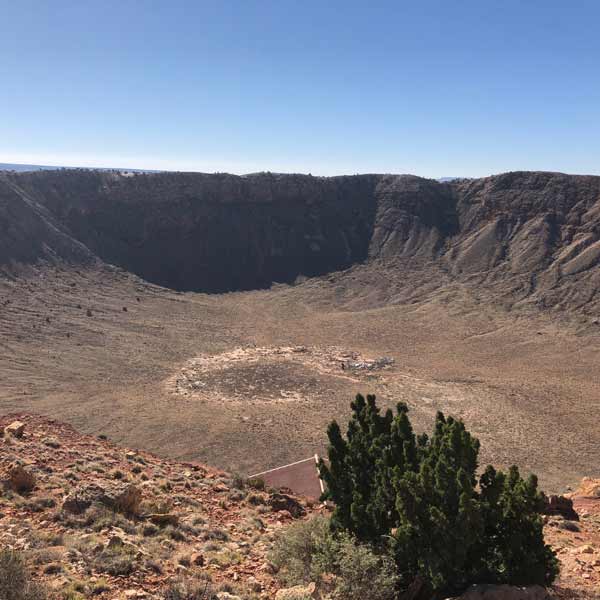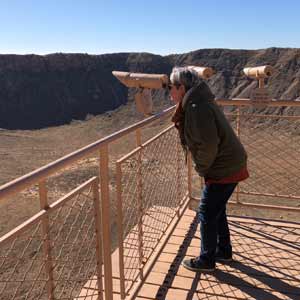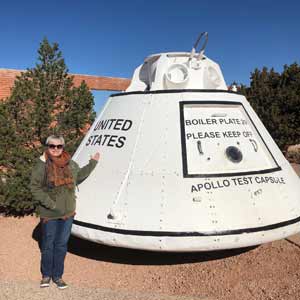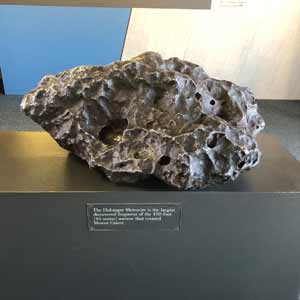A meteor crater?! When in northern Arizona, be sure to put this notable and curious landmark on your To Do List.
 This past fall, we spent two dizzying months zipping from our home in northern Illinois to visit our daughter in Los Angeles, California. Along the way, there were sights and things to see that were truly mind-boggling. One of these is the Meteor Crater in northern Arizona, just a few miles off of I-40.
This past fall, we spent two dizzying months zipping from our home in northern Illinois to visit our daughter in Los Angeles, California. Along the way, there were sights and things to see that were truly mind-boggling. One of these is the Meteor Crater in northern Arizona, just a few miles off of I-40.
First, some background on this amazing landmark: Located 37 miles east of Flagstaff, Arizona and 18 miles west of Winslow, the crater is actually named after the nearest post office, Meteor (probably named after the crater — I know, odd). It was formerly known as the Canyon Diablo Crater, while scientists refer to it as the Barringer Crater, named after mining engineer and businessman, Daniel Barringer, who first suggested it was produced by a meteorite impact.
The crater is privately owned by the Barringer family and is not protected as a national monument (which would require federal ownership). It was designated a National Natural Landmark in 1967. The Barringer Company runs the visitors center at the crater site.
 The crater is about 3,900 feet in diameter, 560 feet in depth, and is surrounded by a rim that rises 148 feet above the surrounding plains. The educational film viewed in the visitor’s center notes that 20 full-sized football fields could fit on the crater floor and, if the crater was a stadium, 2 million spectators could be seated.
The crater is about 3,900 feet in diameter, 560 feet in depth, and is surrounded by a rim that rises 148 feet above the surrounding plains. The educational film viewed in the visitor’s center notes that 20 full-sized football fields could fit on the crater floor and, if the crater was a stadium, 2 million spectators could be seated.
The crater was created about 50,000 years ago when a nickel-iron meteorite about 160 feet across collided with the earth at a speed between 29,000 and 45,000 miles per hour (there is some disagreement between experts). Half of the meteorite’s mass was vaporized during the descent, while the remaining amount was completely obliterated in the impact. The estimated explosion is estimated at the equivalent of a 10 megaton bomb (that’s 20,000 pounds of TNT).
 During the 1960s and 1970s, NASA astronauts trained in the crater to prepare for the Apollo missions to the moon. In fact, on the observation platform, you can look through a telescope and see a representation of the size of an astronaut in relation to the size of the crater.
During the 1960s and 1970s, NASA astronauts trained in the crater to prepare for the Apollo missions to the moon. In fact, on the observation platform, you can look through a telescope and see a representation of the size of an astronaut in relation to the size of the crater.
 The visitor center (an admission fee is charged to support operations and further improvements to the experience) features interactive displays and exhibits about meteorites and asteroids, space, the solar system, and comets. There is an American Astronaut Wall of Fame and artifacts such as an Apollo command module, another 1,406-pound meteorite found in the area, and meteorite specimens from the Meteor Crater. There is a movie theater, gift shop, and an observation area. Guided tours are available daily, weather permitting.
The visitor center (an admission fee is charged to support operations and further improvements to the experience) features interactive displays and exhibits about meteorites and asteroids, space, the solar system, and comets. There is an American Astronaut Wall of Fame and artifacts such as an Apollo command module, another 1,406-pound meteorite found in the area, and meteorite specimens from the Meteor Crater. There is a movie theater, gift shop, and an observation area. Guided tours are available daily, weather permitting.
About a half mile off of I-40 (take exit 233), you’ll find Meteor Crater RV Park, with room for big rig RVs and featuring a gas station and country store. If you’re traveling through northern Arizona, be sure to take an hour or two to stop at this fascinating sight.

